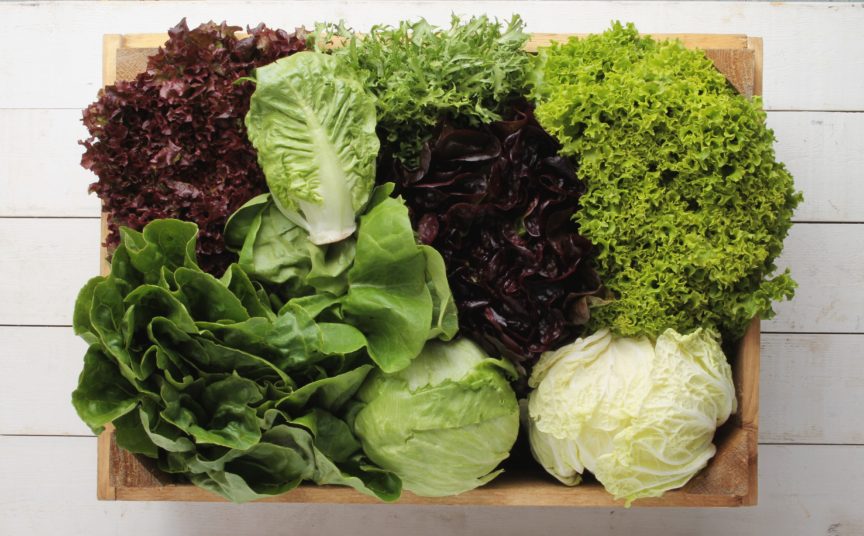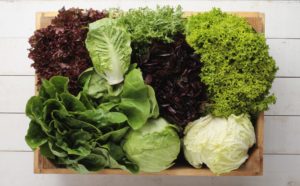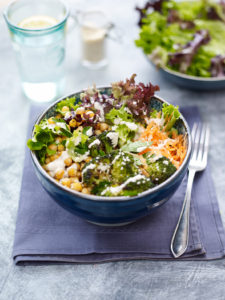 The first bagged salad was a shredded iceberg sold by Marks & Spencer in 1986. Today we have a wider choice of leafy salad available to enjoy than ever before.
The first bagged salad was a shredded iceberg sold by Marks & Spencer in 1986. Today we have a wider choice of leafy salad available to enjoy than ever before.
Advances in farming mean that a wider variety of salads are now grown and supplied with better yields from around Europe. The name lettuce is derived from the Latin word “Latucca,” which refers to the vegetable’s milky sap and it is believed that the Romans introduced it to Britain and the word salad comes from the Latin word “herba salta” or “salted herbs,” so called because such greens were usually seasoned with dressings containing lots of salt.
Iceberg was given its name as a result of the leaf being developed in America and being packed with ice so as to survive transport in warm temperatures. In the late 1980s and early 1990s, lettuces known as ‘continental’ or ‘specialty’, such as Batavia, Lollo Rosso and Romaine, began to be grown here after being introduced from Europe. In the late 1990s baby leaf and further specialty leaves such as rocket were grown in the UK.
Lettuce was first eaten by the ancient kings of Persia 2,500 years ago. The ancient Greeks and Romans thought it helped you to have a good night’s sleep, and the lettuce we see today started out as a weed around the Mediterranean basin. In ancient Egypt, lettuce was believed to be sacred to the fertility god Min and considered to be a powerful aphrodisiac. The first representation of salad appeared in paintings on Egyptian tombs in 4500 BC.
Many of the health benefits that leafy salads provide come from unique plant compounds known as phytochemicals (also called phytonutrients). These are chemical compounds that are considered to be beneficial to human health. For example Romaine/Cos and spinach contain lutein, while watercress and rocket contain glucosinolates.
Salad leaves are classified as vegetables and one cereal/dessert bowl full, or 80g of salad leaves, counts as one portion of your ‘5 a day’. We are encouraged to ‘eat a rainbow’ of fruit and vegetables for variety and to ensure we get all the nutrients we need to stay healthy. Salad leaves are ideal, ranging in colour from red through to dark green. Generally the darker or more coloured a leaf, the more phytonutrients it may contain.
Energy density is the amount of energy or calories in a particular weight of food (kcal per gram). Foods with a lower energy density provide fewer calories per gram than foods with a higher energy density. For the same amount of calories, a person can consume a larger portion of a food lower in energy density than a food higher in energy density.
As a low-energy dense food, salad leaves can help with weight loss and appetite. In one study participants were given a standard lunch on different occasions, each time with either a first-course salad or with no salad (1). Participants consumed fewer calories when the meal started with the lower-energy-dense salad and they reported feeling just as full as participants who had no first-course salad but had eaten more of the main course, or had a salad that was higher in energy density.
Salad leaves are a low energy dense food, providing on average only 11kcal per portion or 14kcal per 100g and are naturally low in calories, fat and sodium. Lettuce is also high in fibre. This means you can enjoy large servings without having to worry about the calories, but just watch what you’re adding as dressings and toppings can add calories, fat and salt.
Research has highlighted how different nutrients and phytochemicals (‘phyto’ meaning plant), including different carotenoids, work best as a team. For example, vitamins C and vitamin E, which also have an antioxidant role, help enhance the benefits of phytochemicals too. This is one very important reason why eating a variety of different fruit and vegetables is so beneficial to our health. It may also help to explain why regularly eating nutrient-packed green leafy vegetables, has been strongly linked with maintaining good health.
Information from www.makemoreofsalad.com
- Rolls BJ, Roe LS, Meengs JS. Salad and satiety: energy density and portion size of a first course salad affect energy intake at lunch. Journal of the American Dietetic Association 2004;104:1570-1576.
Nutritional content of lettuces
Lettuce is a source of vitamin A, folic acid and manganese, and a good source of vitamin K. Rocket is a source of vitamin C and calcium, and a good source of vitamin K, folic acid and potassium. Red leaf lettuce is a good source of vitamin A and vitamin K. Spinach is a source of potassium, calcium and iron, and a good source of vitamin A, vitamin K, vitamin C and manganese. Watercress is a source of folic acid, chloride, calcium and iron and a good source of vitamin A (as carotenes), vitamin K, vitamin C and manganese. Many of these are important for a healthy immune system, a healthy heart and circulation, bones and healthy skin. As different leaves offer different nutrients, eating a wide variety of mixed leaves is a good idea.
Food features and recipes like this appear in the Desang Diabetes Magazine, our free-to-receive digital journal. We cover diabetes news, diabetes ‘kit’ and information on food suitable for maintaining good blood glucose control or a diabetic diet, including a regular Making Carbs Count column. It’s free! Go to the top of this page to sign up – we just need your email address. See current and past issues at
www.desang-magazine.co.uk



